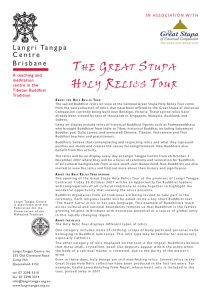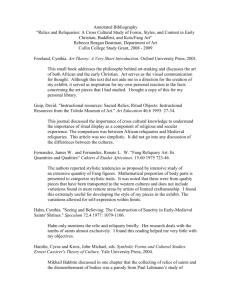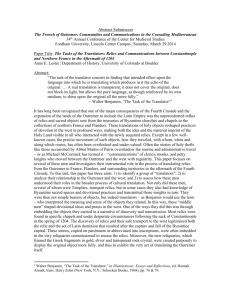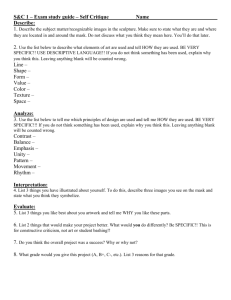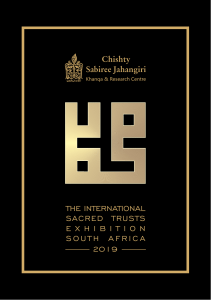TheArt
advertisement
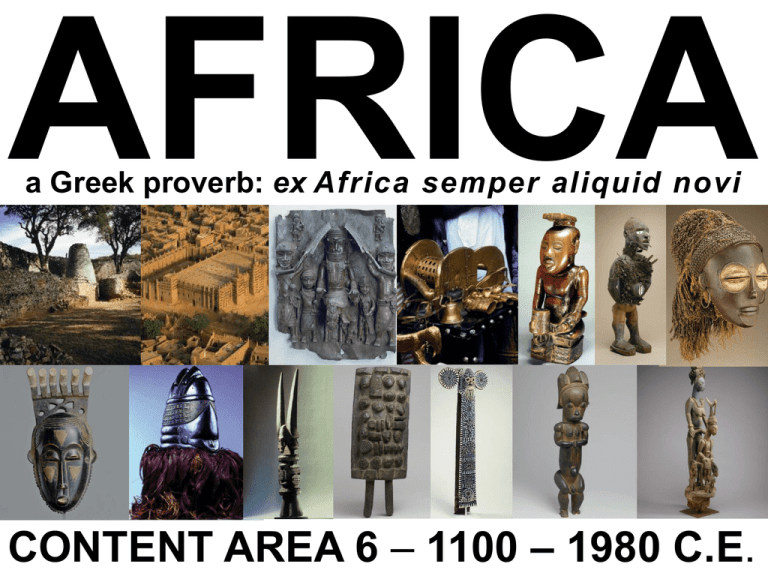
AFRICA a Greek proverb: ex Africa semper aliquid novi CONTENT AREA 6 – 1100 – 1980 C.E. STYLE OF AFRICAN ART • Art was part of all important aspects of society Coming of age, leadership, family communion • Art was meant to be a spiritual encounter Often used in rituals and worship • Small and portable figures and pieces are common • Often made of wood and accessorized with feathers, fabric, and beads • Bodies are unrealistic Fingers are rarely used • Important sculpture is made for a definite purpose, not for decoration Masks represent a particular spirit, that only comes alive during ceremonies The Art – Conical tower and circular wall -Granite -Modeled on traditional shapes of grain silos -control over food stores is a powerful thing - likely a royal residence -walls slope inward toward the top -internal and external passageways The Art - Great Mosque of Djenné -central tower is a mihrab -adobe-type building, quite large an impressive for its constructive style -UNESCO World Heritage Site -rebuilt multiple times over the centuries mih·rab (mîr′əb)n. A niche in the wall of a mosque or a room in the mosque that indicates the direction of Mecca The Art - Wall plaque from Oba’s palace -high relief, brass -used to decorate the walls of the royal palace -displayed aspects of court life -largest, central figure is the most important The Art – Sika Dwa Kofi – Golden Stool -wooden substructure, golden coating and details -contains the “soul of the nation” -can be touched by the King alone The Art – Ndop – Portrait Figure -wooden -commemorative portrait of the Kuba ruler at the time The Art – Nkisi n’kondi – Power Figure -wood and metal -sacred and divine spiritual protection for the people -a container of sacred substances The Art – Female (Pwo) Mask -The Democratic Republic of the Congo -worn by men but intended to honor child-bearing, courageous, women -worn with slow, graceful, fluid movements -she deserves respect The Art – Portrait Mask - Mblo -made on Cote d’Ivoire -”nuanced individuality, highly refined details, and powerful presence” -serenity The Art – Bundu Mask -worn by women during cultural ceremonies -Sierra Leone, Liberia -made to help young girls become women and housewives – an initiation -black, shiny surface is ideal -elaborate hairstyle The Art – Ikenga shrine figure -stood for the power of the right hand -personal objects that related to the achievements of its commissioner -the right hand (often)holds the sword, the power to push through life and break barriers ”A RAM FIGHTS WITH HIS HEAD FIRST” The Art – Lukasa – Memory Board -portable wooden object -”concept map” of society’s political structure and inner workings (Luba society) -incised designs, images carved in relief -human faces (depicitions of important members of society) are evident The Art – Aka Elephant Mask -use in performance and celebrations to honor the ruler -worn with full costume -highly stylized -worn in Cameroon, used to suggest the power of the king The Art – Reliquary Guardian Figure -wooden -guarded a container for relics and mementoes that had great weight for their owners -balance between calm, reserved appearance and obvious physical power represented in the sculpture -not “natural” – an abstraction RELIQUARY OF SAINTE-FOY -housed in Conques, France -Sainte Foy was a Roman martyred during 303 C.E.’s Diocletian persecutions -figure of a masculine woman -still contains relics -last remaining example of its type -head is distinctly late Roman -possibly death mask of Charlemagne rel•i•quar•y /ˈreləˌkwerē/ noun BYERI RELIQUARY FIGURE IN CAMEROON -counter to Western traditions of naturalism and realism (accurate portrayal of the human form) -reduced to a series of basic shapes -grasped hands indicate sense of tense anxiety -positioned atop wooden boxes and cylinders containing relics -meant to guard the sacred objects from danger and intrusion A container for holy relics, a container or shrine in which sacred relics are kept. In Christianity, reliquaries are a means for protecting and displaying relics, items often associated with saints or other figures or great relevance. Relics are… “MORE VALUABLE THAN PRECIOUS STONES AND MORE TO BE ESTEEMED THAN GOLD.” The Artist - Olowe of Ise -Born – 1875, Died – 1938 -important artist of Yoruba people -carved wood for rulers of a Nigerian kingdom The Art – Veranda post of Enthroned King and Senior Wife -intended to be a structural support in a palace -designed by the aforementioned artist in SW Nigeria -king is center focus, but others offer support -scale of the wife implies importance THEME: Family Veranda Post of Enthroned King and Senior Wife, Sarcophagus of the Spouses Etruscan • Both represented common ritual among cultures – Veranda Post: coronation – Sarcophagus of the Spouses: banquet • Portrays relationship between husband and wife – Veranda Post: wife crowned king, position and size signify importance – Sarcophagus of the Spouses: supportive “IN AFRICAN ART, IT’S OFTEN NOT SO MUCH ABOUT WHAT THE FIGURE LOOKS LIKE BUT RATHER THE CONCEPT IT’S TRYING TO CONVEY.” RESOURCES EMPLOYED →Barron’s AP Art History, 3rd Edition →The AP Art History Curriculum Framework – Content Area 6 – Africa →https://www.khanacademy.org/

